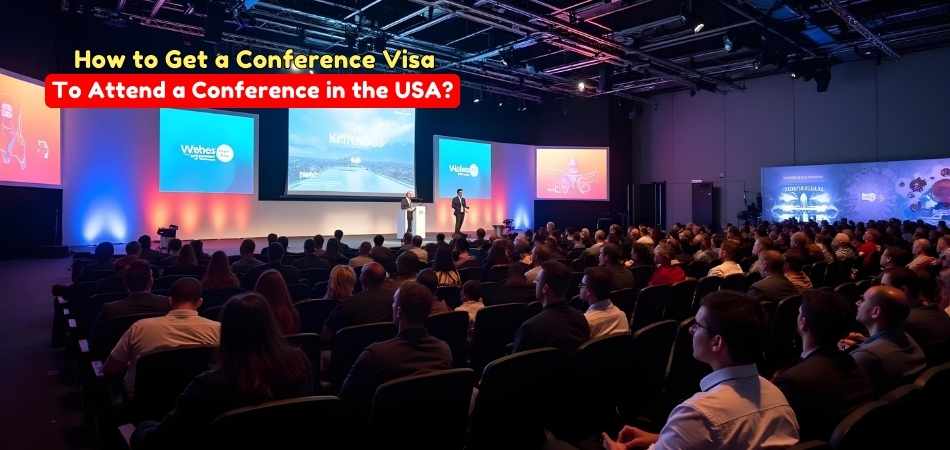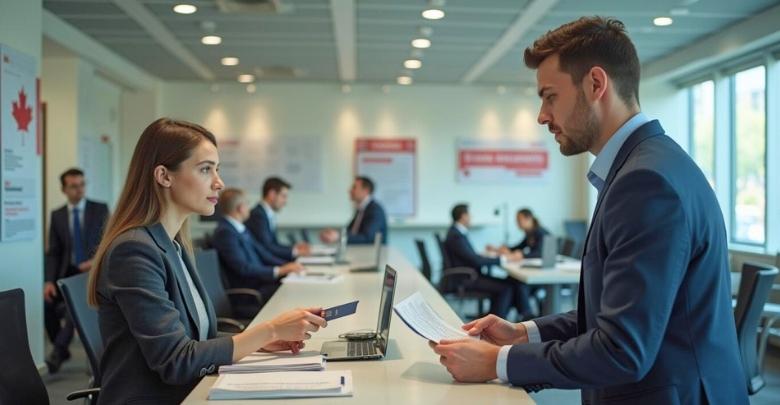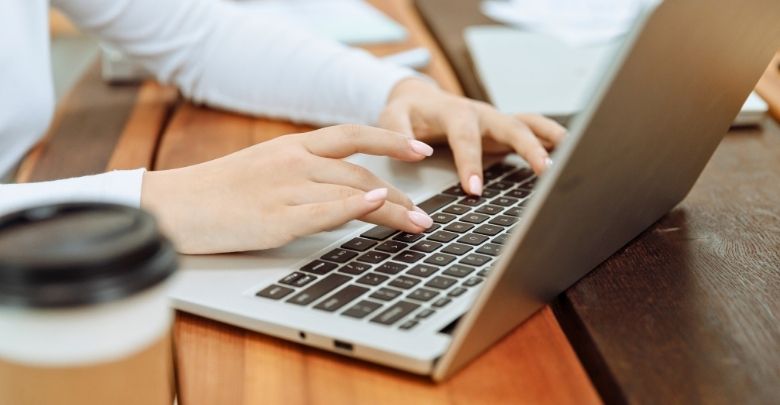Securing a USA visa can feel like a detailed process, especially if you’re planning to attend a professional event. You might already be wondering how to get a conference visa to attend a conference in the USA without unnecessary complications.
To get a USA conference visa, you have to apply for a B-1 Business Visitor Visa. Submit the DS-160 form, provide documents like your passport and conference invitation, pay the fee, and attend a visa interview. Early planning ensures a smooth process.
Are you curious about what steps to take or how to make your application stress-free? Keep reading! This article provides all the essential details you need to confidently apply for your conference visa.
How to Get a Conference Visa to Attend a Conference in the USA Without Hassle?
It can be a rewarding experience to attend a conference in the USA, which provides excellent chances to network with professionals in your field and discover emerging trends. However, securing a conference visa requires careful planning. For a smooth process, here is all the information you need.
Step 1. Know the Visa Type You Need
To attend a conference in the USA, you will generally need a B-1 Business Visitor Visa. This visa is specifically for business-related visits, including conferences, seminars, and meetings. Make sure your visit aligns with these guidelines. Make sure you select the correct visa type to avoid complications during your application and interview process.
Step 2. Start Early to Avoid Delays
Visa processing times can vary widely depending on your country and local embassy workload. Begin your application at least two to three months in advance. This ensures you have enough time to handle unexpected delays or requests for additional documents. Early preparation is key to avoiding unnecessary stress and last-minute hurdles.
Step 3. Gather All Required Documents
You’ll need a set of documents for your visa application. These include your passport, conference invitation, registration proof, financial evidence, and documents showing ties to your home country, like employment or education. Having these ready will make the process smoother and strengthen your application during the review stage at the embassy.
Step 4. Highlight the Purpose of Your Visit
When completing your application and attending the interview, clearly outline your purpose. When you’re planning to attend upcoming conferences in USA, explain how this aligns with your work or studies. This not only demonstrates the relevance of your visit but also establishes your genuine intent to return home after the event.
Step 5. Complete the DS-160 Form
The DS-160 form is an essential part of your visa application. Fill out this online form with accurate details matching your supporting documents. After submission, you’ll receive a confirmation page with a barcode. Keep this document safe, as it’s required for your interview appointment and further application steps.
Step 6. Schedule and Prepare for Your Interview
After submitting the DS-160 form, schedule a visa interview at your nearest U.S. embassy or consulate. Prepare for questions about your trip, such as why you are attending the conference, how it benefits you, and your financial arrangements. Practice concise and honest responses to avoid any confusion or misunderstandings.
Step 7. Pay the Visa Application Fee
The USA visa application fee for a B-1 visa is typically $160, though it may vary based on your location. This fee is non-refundable, so ensure your payment is accurate and verified. Keep the receipt, as it’s required during the application process. Payment details are usually listed on the embassy’s official website.
Step 8. Show Proof of Financial Stability
To assure the embassy that you can sustain yourself during your visit, provide evidence of financial stability. This could include recent bank statements, a sponsorship letter, or an employer’s support letter. Financial documents demonstrate that you can afford travel, accommodation, and conference expenses without financial difficulty.
Step 9. Confirm Your Travel Arrangements
While booking flights or hotels isn’t mandatory before visa approval, having a tentative itinerary can help. Include details like the conference’s dates, venue, and nearby accommodations. This reassures the consulate that you have a clear plan for your visit and are focused on the event’s purpose.
Securing a visa to attend a conference in the USA requires careful preparation and organization. By following these steps, you can make the process efficient and focus on the conference without unnecessary worries.
Some Common Questions Asked During A Visa Interview for USA Conference Attendees
Visa interviews for attending conferences in the USA often focus on figuring out the purpose of travel, financial plans, and ties to home. Being well-prepared ensures a smoother process. Below are key questions commonly asked:
- What Is The Purpose Of Your Visit To The USA?
Explain the specific reasons for attending the conference and how it relates to your work or interests. - Can You Provide Details About the Conference You Are Attending?
Discuss the name, location, schedule, and purpose of the conference, showing familiarity with its objectives. - What Is Your Current Profession Or Academic Background?
Describe your current position, field of study, or research and how it connects with the conference. - Who Is Funding Your Trip To The USA?
Clarify whether your trip is self-funded, employer-sponsored, or supported by another organization, and provide proof if needed. - What Are Your Travel Dates And Where Will You Stay In The USA?
Share your planned itinerary, including arrival and departure dates and details of your accommodation arrangements. - Do You Have Any Ties To Your Home Country?
Reassure the interviewer of your intent to return home by mentioning family, job, or educational commitments. - Have You Traveled Internationally Before?
Provide information about your past travel history, particularly if you’ve visited the USA or similar destinations.
Prepare thoroughly for these common questions to ensure a smooth visa interview process. Confidence, clarity, and honesty are crucial when sharing your purpose, plans, and ties to your home country. A well-prepared approach increases your chances of approval.
How to Confirm Your Visa Application Fee for USA Conferences?
Paying the visa application fee for attending a USA conference is a crucial step that requires attention to detail. Without following the correct process, your application may face delays. Here is a simple guide to assist you.
Check the Embassy Website for Payment Methods
The first step is to visit the official website of the U.S. embassy or consulate in your country. Payment methods often vary, including local bank deposits, online transactions, or direct card payments. Carefully review the instructions to confirm the accepted options. Using unofficial sources can lead to errors, so rely only on the embassy’s website for accurate details.
Discover Your Visa Type Before Payment
Confirm the correct visa category, such as the B-1 Business Visa for conferences. When you are exploring visa options for USA conferences, double-check that the fee you’re paying aligns with your selected visa. Each visa type has specific fees, and paying for the wrong category can delay or disrupt your application. Always double-check fee structures before proceeding with any payment.
Keep Your DS-160 Form and Passport Ready
When making your payment, ensure your DS-160 form and passport are easily accessible. You’ll often need the application ID and personal details during this process. Errors in providing this information can lead to delays, so take the time to cross-check all entries before finalizing your payment.
Verify Transaction Details After Payment
After completing the payment, request a receipt and ensure all details, such as the amount paid and the transaction ID, are accurate. This receipt is mandatory for scheduling your visa interview. If you detect errors in the receipt, immediately contact the payment provider or the embassy to resolve the issue promptly.
Reach Out for Assistance If Needed
If you face confusion about the payment process, don’t hesitate to contact the embassy or their helpline. They can provide precise guidance about payment methods and troubleshooting. It’s always better to clarify any doubts than to risk errors that could complicate or delay your visa application process.
Confirming and paying your visa application fee accurately is essential to your application. By following these steps and ensuring all information is correct, you can avoid unnecessary problems and focus on preparing for your trip.
What Should You Do if You Lose the Receipt for Your USA Visa Application Payment?
Losing your USA visa application payment receipt can be stressful, but there are ways to address it effectively. Taking the right steps quickly is important to avoid delays in your application process. Follow these actionable tips to resolve the issue without unnecessary hassle.
Contact the Payment Issuer Immediately
If you lose your receipt, contact the bank or payment center where the transaction was made. Provide key details like the transaction date, payment amount, and method. Most institutions can verify the payment and may issue a duplicate receipt or provide a transaction reference number for confirmation.
Check Your Email or SMS for Confirmation
Many payment systems send electronic confirmations via email or text after processing a transaction. Search your inbox, spam folder, or phone messages for keywords like “visa payment” or “confirmation.” These messages often contain the receipt or transaction details, which can serve as valid proof of payment.
Visit the Visa Application Center for Assistance
If the payment was made in person at a visa application center, visit them directly to explain the situation. Bring any supporting documents, like payment slips or your application number. Staff members can often retrieve your payment record or guide you on the necessary steps to resolve the issue.
Log In to the Visa Application Portal
Access your online application account, as most systems record payment details within your profile. Look for an option to download your receipt or view transaction information. If this option is available, it provides a convenient way to retrieve proof of your payment quickly and easily.
Gather and Present Alternative Proof of Payment
If a duplicate receipt cannot be obtained, gather other evidence like bank statements, payment screenshots, or transaction reference numbers. Submit these along with a detailed explanation to the embassy or consulate. These documents can help confirm your payment and prevent delays in your visa processing.
Addressing a lost payment receipt requires quick action and careful organization. Follow the steps outlined above, stay calm, and communicate clearly with the relevant authorities to ensure your visa application process continues without major disruptions.
How Far in Advance Should You Schedule Your USA Visa Interview to Avoid Delays?
One of the most important steps in organizing a conference in the United States is setting up your interview for a USA visa. Timing this correctly is key to ensuring that you avoid delays and complications. Below is a detailed guide to help you determine the best time to set up your visa interview.
Check Visa Processing Times Regularly
Before scheduling your interview, review the visa processing times in the USA. Department of State website. Processing times vary based on embassy location and application volume. Check these updates frequently to plan. Being aware of the timelines helps you determine when to schedule your interview to avoid unnecessary delays.
Schedule Early to Accommodate Delays
To prevent unexpected visa processing delays in USA, aim to schedule your visa interview at least three to four months before your planned travel date. This window allows time for possible delays and ensures that your visa is likely to be processed well before your departure.
Account for Seasonal Peaks
Peak travel seasons like summer or holiday months can significantly impact embassy workload and appointment availability. Schedule your interview during off-peak times to reduce wait times. Embassies often face higher demand during busy seasons, which can delay processing if you wait too long to book your slot.
Monitor Appointment Openings Closely
Visa interview appointments can fill up quickly, especially at busy embassies or consulates. Regularly check the embassy’s appointment system to secure the earliest available date. Act promptly when you find an open slot to avoid missing critical deadlines for your planned travel and event attendance.
Prepare for Rescheduling if Necessary
Unexpected circumstances, such as technical issues or personal emergencies, may require you to reschedule your interview. Follow the embassy’s rescheduling guidelines and plan for contingencies. Flexibility in your travel plans ensures that minor changes won’t affect your overall schedule or your ability to attend the conference.
Scheduling your visa interview well in advance is essential for avoiding last-minute challenges. Following these steps will help you stay organized, minimize stress, and focus on completing the visa process for your planned visit to the USA.
FAQs About Getting a Conference Visa
When planning to attend a conference in the USA, many questions can arise about the visa process. Addressing these concerns ensures a smoother application process. Below are a few FAQs that provide essential insights about obtaining a conference visa.
Can I Bring Family Members on a B-1 Visa?
No, family members cannot travel on your B-1 visa as it is solely for business purposes like conferences. They can apply for a B-2 Tourist Visa, which permits leisure travel and accompanying you to the USA. Ensure they meet the application requirements, including financial support and intent to return.
Is Health Insurance Mandatory for a Conference Visa?
Health insurance is not a mandatory requirement for a B-1 visa, but it is strongly advised. Medical expenses in the USA can be very high. Having travel insurance with comprehensive health coverage protects you against unexpected medical emergencies, ensuring peace of mind during your conference visit.
How Long Can I Stay in the USA on a B-1 Visa?
The B-1 visa typically permits stays of up to six months, but the exact period is determined by the Customs and Border Protection officer upon entry. Ensure you comply with the authorized stay and leave the USA before it expires to avoid visa complications or potential bans.
Can I Apply for a Conference Visa If I Am Self-Employed?
Yes, self-employed individuals are eligible to apply for a B-1 visa. You need to provide proof of your business, such as registration documents, tax returns, or invoices. Highlight how the conference benefits your professional goals and ensure all other documentation aligns with visa requirements.
What Should I Do If My Visa Is Denied?
If your visa application is denied, carefully review the explanation provided by the embassy. Address the highlighted issues, gather additional supporting documents, and reapply if applicable. Be sure to clearly state your conference’s purpose and meet all the required criteria in your updated application.
Can I Attend Multiple Conferences on One B-1 Visa?
Yes, the B-1 visa allows you to attend multiple conferences during its validity period. Inform the consular officer about your plans during the interview and carry supporting documents for all events. Ensure each conference aligns with the visa’s purpose and does not exceed the authorized duration of stay.
Final Words
Securing a visa for a conference in the USA may seem challenging, but with proper planning, it becomes manageable. By reviewing the process, gathering the required documents, and preparing for your interview, you’ll have no trouble answering how to get a conference visa to attend a conference in the USA.
Make sure you apply early, stay organized, and communicate clearly during the visa process. Double-check your documents, stay calm, and present yourself confidently during your interview. Best wishes for a smooth visa application and an enriching conference experience!








